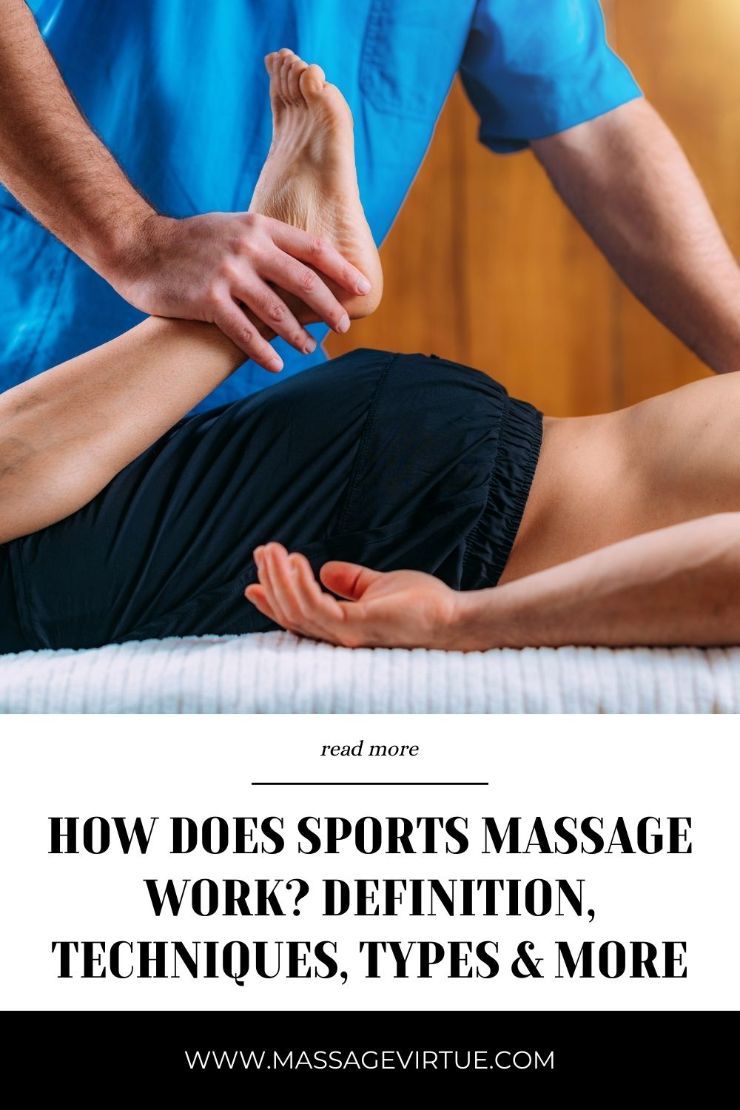If you’re an athlete, coach, trainer, or simply someone who’s passionate about sports and physical fitness, you’ve likely heard of sports massage.
But have you ever wondered, “How does sports massage work?”
This article is here to demystify the magic behind sports massage, shedding light on its benefits, types, frequency, what to expect during a session, and whether it’s the right choice for you.
How Does Sports Massage Work?
Sports massage involves targeted manipulation of soft tissues to improve athletic performance and aid recovery.

It works by enhancing blood circulation, reducing muscle tension, and promoting the release of endorphins.
This helps alleviate pain, prevent injury, and increase flexibility and range of motion.
Sports massage also addresses specific issues like knots, adhesions, and scar tissue.
Optimizing muscle function and reducing post-exercise soreness, contributes to better overall physical performance and fitness.
Benefits of Sports Massage
Sports massage isn’t just a luxurious treat for athletes; it offers tangible benefits for both the body and mind. Whether you’re a professional athlete or a weekend warrior, here’s what sports massage can do for you:
1. Enhanced Muscle Recovery
After rigorous training or competition, your muscles can become sore and fatigued.
Sports massage promotes blood flow, helping to eliminate waste products and deliver essential nutrients to the muscles.
This, in turn, speeds up the muscle recovery process, allowing you to bounce back quicker after a tough workout.
2. Improved Athletic Performance
By loosening tight muscles and enhancing flexibility, sports massage can optimize your athletic performance.
You’ll find yourself moving more efficiently, which translates to improved agility and performance on the field, track, or court.
Additionally, reduced muscle tension and increased flexibility lead to a decreased risk of injuries.
3. Injury Prevention and Management
Sports massage goes beyond relaxation; it’s a proactive measure in identifying and targeting specific muscle imbalances or areas of tension.
This helps prevent injuries by addressing trouble spots before they become problematic.
For those already dealing with injuries, sports massage aids in their management, helping you recover faster and get back to your active lifestyle.
4. Stress Reduction
The benefits of sports massage aren’t limited to the physical realm; it has a positive impact on your mental well-being as well.

It helps reduce stress and anxiety, providing a sense of relaxation and overall well-being.
Athletes often face intense pressure, and sports massage serves as an effective stress reliever, allowing you to stay mentally resilient.
5. Increased Range of Motion
Sports massage works to release tension and knots in muscles and fascia.
This, in turn, contributes to an improved joint range of motion, enabling you to perform at your peak level.
Whether you’re reaching for a high volley in tennis or sprinting toward the finish line, an enhanced range of motion is your ally.
Types of Sports Massage
Now, let’s explore the different types of sports massage in more detail:
1. Swedish Massage
Known for its gentle and relaxing strokes, Swedish massage is often used as a pre-event warm-up. The long, flowing strokes increase circulation, improve flexibility, and reduce muscle tension.
It’s an ideal choice to prepare your body for a competition or rigorous training session, promoting both relaxation and readiness.
2. Deep Tissue Massage
When you need to address chronic muscle pain or specific injuries, deep tissue massage steps up to the challenge.
This technique goes deeper into the muscles, targeting knots, adhesions, and areas of tension.
By applying firm pressure and slow strokes, deep tissue massage provides effective relief and aids in the rehabilitation of injured muscles.
3. Trigger Point Massage
Focusing on trigger points, this technique is a highly precise method to release tight knots within muscles.

These knots, also known as trigger points, can cause referred pain and discomfort.
Trigger point massage alleviates pain, reduces muscle tension, and enhances flexibility by directly addressing these problematic areas.
How Often to Get a Sports Massage?
The frequency of sports massages depends on your level of physical activity, your specific needs, and your budget. Professional athletes may benefit from more frequent sessions, while weekend warriors can see results with less frequent visits. Here’s a general guideline:
- Maintenance: One session per week to address specific issues or maintain muscle health.
- Pre-Event: A session a day or two before a major competition can help you perform at your best.
- Post-Event: A post-competition massage can aid recovery and reduce muscle soreness.
What to Expect During a Sports Massage?
| Expectation | Description |
| Consultation | Your therapist will discuss your goals, specific issues, and medical history to tailor the massage to your needs. |
| Undressing | You’ll be asked to undress to your comfort level. You’ll be appropriately draped throughout the session. |
| Massage Techniques | Your therapist will employ various techniques to address your concerns, whether it’s muscle tension, pain, or stress. |
| Feedback | Feel free to communicate with your therapist about pressure and comfort during the session. |
| Hydration | After the massage, it’s essential to drink plenty of water to aid in flushing out toxins from your system. |
Is Sports Massage Right for Me?
Now, the big question: is sports massage the right choice for you? The answer largely depends on your goals and lifestyle.
1. Athletes: If you’re a dedicated athlete, sports massage is an excellent choice to enhance your performance, prevent injuries, and aid in recovery.
2. Coaches and Trainers: Coaches and trainers can recommend sports massage to their athletes as a valuable addition to their training routine. It can help athletes reach their full potential.
3. Active Individuals: Even if you’re not a professional athlete, sports massage can be beneficial for anyone leading an active lifestyle. It helps reduce pain, improves flexibility, and promotes relaxation.
Conclusion
In conclusion, sports massage is a versatile tool that can benefit a wide range of individuals.
Whether you’re seeking improved athletic performance, faster recovery, or just a way to relax and destress, sports massage has something to offer.
By understanding its benefits, types, frequency, and what to expect during a session, you can make an informed decision about incorporating sports massage into your life.
FAQs
What Happens to Your Body During a Sports Massage?
During a sports massage, your muscles experience increased blood flow.
This helps in flushing out toxins and delivering essential nutrients to aid in muscle recovery and relaxation.
Do Sports Massages Help?
Yes, sports massages have proven benefits. They aid in muscle recovery, enhance athletic performance, reduce the risk of injuries, alleviate stress, and increase flexibility and joint range of motion.
Do I Have to Take My Clothes Off for a Sports Massage?
You’ll be asked to undress to your comfort level. However, you’ll always be appropriately draped during the session to ensure your privacy and comfort.
What Are the Disadvantages of Sports Massage?
While sports massage offers numerous advantages, some potential disadvantages include the cost, as frequent sessions can add up, and the pressure during the massage may be uncomfortable for some individuals.
It’s essential to communicate your preferences with your therapist to make the experience enjoyable and effective for you.


